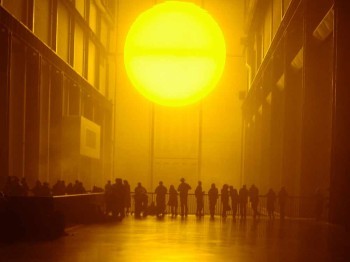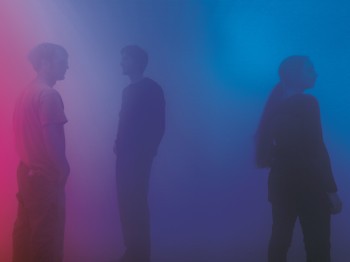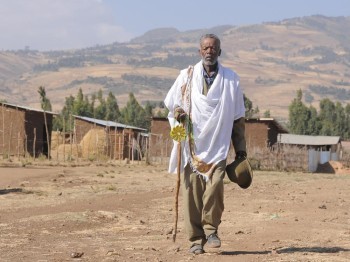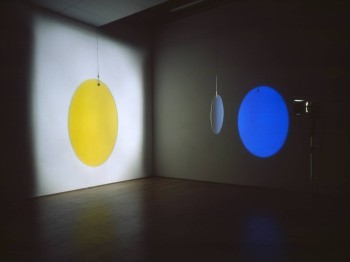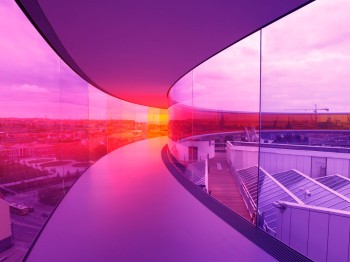Olafur Eliasson
2014 Recipient of the Eugene McDermott Award in the Arts at MIT
About the Award
The Eugene McDermott Award in the Arts at MIT recognizes rising, innovative talents and offers the recipient a $100,000 prize and a campus residency. Established in 1974 by the Council for the Arts at MIT, the Award is bestowed upon individuals whose artistic trajectory and body of work indicate that they will achieve the highest distinction as leaders in their fields. One of the most generous arts honors in the US, the Award reflects MIT’s commitment to risk-taking, problem solving and to the idea of connecting creative minds across disciplines. The McDermott Award is considered an investment in the recipient’s future creative work, rather than a prize for a particular project or lifetime of achievement.
The Residency
A distinctive feature of the Award is a campus residency, which includes a celebratory event at which the Award is presented, a public presentation of the artist’s work and significant interactions with students, faculty and staff. The goal of the residency is to provide the recipient unparalleled access to the creative energy and cutting-edge research found in the MIT community and to have the recipient connect with departments, laboratories and research centers throughout the Institute in ways that will be mutually enlightening.
2014 McDermott Award recipient Olafur Eliasson’s collaboration with MIT focuses upon his art and social business enterprise Little Sun, a portable, solar powered lamp which he calls “a work of art that works in life.” Renowned for his large-scale public art projects and architectural works, Eliasson’s Little Sun is perhaps his most ambitious work of art to date, as it forms the architecture of a vast global network, bringing together people, places and resources towards the common goal of more equitably distributing the world’s power, both literally and figuratively.
The artist’s activities on campus will center around discussions of sustainable development, community engagement, design, product engineering and social entrepreneurship in developing economies. He will engage with the MIT Energy Initiative (MITei), a multidisciplinary, Institute-wide research program working to find secure, economically viable and environmentally sustainable energy sources, the MIT DLab (Development through Dialogue, Design and Dissemination), the Sloan School of Management, the MIT Center for Civic Media and the MIT Museum, among others.
Uniting MIT’s pioneering research with Eliasson’s attention to the sensory and the subjective, the residency reconceptualizes the field of sustainable development beyond the merely functional. The project asks: How can we create an affordable global energy system that factors in human emotion, creativity and desire? Connecting an acclaimed artist such as Eliasson with MIT’s rich culture of innovation presents a profound opportunity to radically expand the discussion around issues of sustainable energy as well as to collectively imagine new and inventive solutions for the future.
The Selection Process
The Eugene McDermott Award in the Arts at MIT may be given to an artist working in any field or cross-disciplinary activity, including architecture, creative writing, dance, design, filmmaking, media arts, music, theater and visual arts. Award nominees are identified by an Advisory Committee, which is composed of international leaders in arts and culture. An Award Committee, chosen by the Council for the Arts at MIT and comprised of arts leaders at MIT, then selects the recipient.
Eugene McDermott
The Award honors Eugene McDermott (1899-1973), cofounder of Texas Instruments and long-time friend and benefactor of MIT. The Eugene McDermott Award in the Arts at MIT was created by the Council for the Arts at MIT in 1974 and further endowed by Eugene’s wife, Margaret.
A geophysicist, Eugene McDermott was a member of the MIT Corporation from 1960 to 1973. The scholarship funds he established at MIT reflect his commitment to education and the public art he donated a conviction, shared with his wife Margaret, that the physical environment of a campus has great influence upon the character of an institution. They commissioned Eugene’s Stevens Tech classmate Alexander Calder to create The Great Sail, which was dedicated in 1966 on McDermott Court, facing the Green building. In 1976, the McDermott family and other friends of MIT made a gift of Three Piece Reclining Figure, Draped, by Henry Moore, which graces Killian Court.
Public Events
Past Events
Olafur Eliasson: Holding hands with the sun
Thursday, March 13, 2014 / 5:00pm
MIT Lecture Hall, MIT Building 10-250 (2nd floor)
77 Massachusetts Avenue, Cambridge, MA
Through a general introduction to his wide-ranging work, Olafur Eliasson addressed the question of where an idea begins and the process of an idea becoming embodied in the world. For Eliasson, art is a reality machine. Creativity is not located in the artist’s choice of an individual color; it has to do with the extent to which the artist succeeds in being in sync with the world in making this choice. Creativity is the passage by which the choice becomes ethical and political.
The Art and Science of Solar Lights
Olafur Eliasson with Harald Quintus-Bosz, Chief Technology Officer, Cooper Perkins, Inc.
Friday, March 14, 2014 / 5:00pm
MIT Museum, MIT Building N51
265 Massachusetts Avenue, Cambridge, MA
In the MIT Museum’s popular conversation series, Olafur Eliasson and Harald Quintus-Bosz, Vice President of Engineering at Cooper Perkins, discussed product design in the developing world. Also featuring MIT scientists and designers Evelyn Wang, Jeffrey Grossman, Sheila Kennedy, and Karen Gleason, the program explored the power of design, innovative new materials for capturing and storing solar energy, and inspiring ways of creating solar lighting with flexible materials such as textiles and paper.
Solar Power: Turning ideas into action
Tata Seminar
Wednesday, March 12, 2014 / 5:00pm
MIT Tang Center, MIT Building E51-315
70 Memorial Drive, Cambridge, MA
Olafur Eliasson and Frederik Ottesen, Co-founders of Little Sun, discussed their art and social entrepreneurship venture with Fellows from the Tata Center for Technology and Design. The discussion was moderated by Chintan Vaishnav, Senior Lecturer at the Sloan School of Management. The Tata Center for Technology and Design is part of MIT’s Energy Initiative (MITei) and focuses on the needs of resource-constrained communities in India, taking into account environmental, social and political factors. A core principle of the Center is to be relevant to global societal challenges and needs.
Little Sun Lamp Installation
An installation of over one hundred Little Sun lamps
Spring 2014 – Fall 2014
MIT Museum, MIT Building N51
265 Massachusetts Avenue, Cambridge, MA
Little Sun Video Installation
A four-channel installation of videos about light, life and Little Sun made by eighteen filmmakers from all over the world in response to an invitation from Eliasson was on display in the lobby of the MIT List Visual Arts Center
Spring 2014
List Visual Arts Center, MIT Building E15
20 Ames Street, Cambridge, MA 02130
Hacking Arts
October 3 – 5, 2014
MIT Media Lab Skyline Room
MIT’s annual festival and hackathon exploring the intersection of arts and entertainment, technology, and entrepreneurship. Little Sun CEO Felix Hallwachs was on hand to present the Little Sun as a challenge and mentor attendees. At Hacking Arts, 253 attendees heard from entrepreneurial leaders in a range of creative fields, caught demos from new startups, experienced tech-enabled live performances, and most importantly, dreamt up and actually produced their own tech-based ventures in the space of 48 hours.
During his stay, Little Sun co-founder and engineer Frederik Ottesen mentored two student-led groups formed during the Hacking Arts weekend: Little Sun Community Team, winners of the Little Sun challenge, and the Little Drop Team. Little Sun Community Team is creating an online platform for building connections among vendors around the world and Little Sun fans. It will incorporate a Pinterest-type bulletin board and principles of gamification to offer sales incentives. The site will encourage distributors and vendors to track their progress towards an ultimate goal of delivering sustainable energy to off-grid communities. Little Drop aims to provide an affordable solution for potable water by outfitting Little Sun with an easy-to-use water sterilization straw using solar-charged, battery-powered LED UV-C irradiation. As water is sipped through the straw, a solar-powered germicidal UV LED kills 99% of pathogens in the water.
Energy Night
October 18, 2014
MIT Museum, MIT Building N51
265 Massachusetts Avenue, Cambridge, MA
As part of Studio Olafur Eliasson’s engagement with the MIT community, Little Sun co-founder and engineer Frederik Ottesen worked with MIT faculty and students on the development of new ideas to expand the Little Sun project. His visit culminated with an appearance at MIT’s popular Energy Night, an annual student-run event featuring over 70 interactive poster presentations that present new research and start-ups in energy renewability, storage, and efficiency, where Little Sun was featured in a prominent installation.
Exploratory Conversations
During his visit, Little Sun co-founder and engineer Frederik Ottesen met with:
Joost Bonsen leads Development Ventures, an MIT course and “action lab” that encourages students to establish, finance and build high-impact, viable ventures in emerging regions for under-served customers. In Bonsen’s course, co-taught with MIT Media Lab professor Sandy Pentland, students are challenged to craft enduring yet economically viable solutions to problems faced by at least one billion people worldwide.
Michael Bove is the Director of the MIT Media Lab’s Object Based Media research group. Bove was responsible for off-grid distribution and engineering for One Laptop Per Child (OLPC), a non-profit organization that distributes inexpensive laptops designed for children in developing countries, established by Nicholas Negroponte, Chairman Emeritus of the MIT Media Lab and Jerome B. Wiesner Professor of Media Technology.
Derek Brine is the Project Manager for CITE, the Comprehensive Initiative on Technology Evaluation, a program developing rigorous testing methodology for products designed for the developing world. CITE is part of MIT’s D-Lab, a global network of innovators designing and disseminating technologies that meaningfully improve the lives of people living in poverty. The program’s mission is pursued through interdisciplinary courses, technology development and community initiatives, all of which emphasize experiential learning, real-world projects, community-led development and scalability.
Robert Stoner is Deputy Director of the MIT Energy Initiative. MITEI links power, innovation, and policy to transform the world’s energy systems. It is an Institute-wide initiative designed to help transform the global energy system to meet the challenges of the future. Through research, education, campus energy management, and outreach activities, the initiative uses an interdisciplinary approach covering all areas of energy supply and demand, security, and environmental impact.
Biography
Olafur Eliasson (IS/DK) was born in 1967. Since 1997, he has exhibited worldwide with major solo shows, such as The curious garden, at Kunsthalle Basel in 1997, The mediated motion, at Kunsthaus Bregenz in 2001, and Chaque matin je me sens différent – chaque soir je me sens le même, at the Musée d’art moderne de la Ville de Paris in 2002. He represented Denmark at the 50th Venice Biennale in 2003 and later that year installed The weather project at Tate Modern, London. Take your time: Olafur Eliasson, a survey exhibition organised by SFMoMA in 2007, traveled until 2010 to various venues, including the Museum of Modern Art, New York. Your chance encounter at 21st Century Museum of Contemporary Art, Kanazawa, in 2009, included the outdoor work Colour activity house. Innen Stadt Aussen (Inner City Out), at Martin-Gropius-Bau in 2010, involved interventions across Berlin as well as in the museum. Similarly, in 2011, Seu corpo da obra (Your body of work), engaged with three institutions around São Paulo – SESC Pompeia, SESC Belenzinho, and Pinacoteca do Estado de São Paulo – and featured ten site-specific installations.
Eliasson’s projects in public space include Green river, carried out in various cities between 1998 and 2001, and the Serpentine Gallery Pavilion 2007, designed together with Kjetil Thorsen and temporarily situated in Kensington Gardens, London, in 2007. The New York City Waterfalls, commissioned by Public Art Fund, were installed on shorelines of Manhattan and Brooklyn during the summer of 2008. Your rainbow panorama, a 150-metre-long circular walkway with colored glass panes situated on top of ARoS Museum in Aarhus, Denmark, opened in May 2011. Harpa Reykjavik Concert Hall and Conference Centre, for which Eliasson created the façade in collaboration with Henning Larsen Architects, was inaugurated in August 2011 and awarded the European Union Prize for Contemporary Architecture Mies van der Rohe Award in 2013.
Together with engineer Frederik Ottesen, Eliasson developed the Little Sun solar-powered light for use in areas of the world without access to electricity. Little Sun was launched at Tate Modern as part of the London 2012 Festival and has been presented at events around the world.
Established in 1995, his studio today numbers about seventy craftsmen, architects, geometers and art historians. In April 2009, as a professor at the Berlin University of the Arts, Olafur Eliasson founded the Institut für Raumexperimente (Institute for Spatial Experiments), a five-year experiment in arts education located in his studio in Berlin.
More at the artist’s website: Olafur Eliasson.
Learn more about the Little Sun.
Press
Press Releases
Olafur Eliasson 2014 Recipient Eugene McDermott Award in the Arts at MIT
(Download the October 24, 2013 Press Release PDF)
Olafur Eliasson at MIT for 2014 Eugene McDermott Award in the Arts at MIT
(Download the February 12, 2014 Press Release PDF)
Contacts
Images and Press Inquiries
Leah Talatinian
Communications Manager, Arts at MIT
617.253.5351
More information about the Eugene McDermott Award in the Arts at MIT:
Leila W. Kinney
Executive Director, Arts Initiatives at MIT
617.324.2062
Artnet News: Olafur Eliasson Will Take Over the Palace of Versailles This Summer
The Guardian: Olafur Eliasson produces cheap solar lamp for developing countries
Huffington Post: 18 Green Artists Who Are Making Climate Change And Conservation A Priority
The Telegraph: Olafur Eliasson: Tate Blackouts Exhibition at Tate Modern: review
Improper Bostonian: School Daze
Big Red & Shiny: Through Abstraction We Shape the World
ArtInfo: Olafur Eliasson Nabs MIT McDermott Award
Wired: Olafur Eliasson in residence at MIT
The Tech: Olafur Eliasson to receive the 2014 Eugene McDermott Award in the Arts at MIT
ARTFIXdaily: Olafur Eliasson Receives 2014 Eugene McDermott Award in the Arts at MIT
Archinect: Olafur Eliasson receives 2014 McDermott Award in the Arts at MIT
Artron: Olafur Eliasson Wins MIT’s 2014 Eugene McDermott Award
Trendbeheer: MIT’s Eugene McDermott Award to Olafur Eliasson
Phaidon: Olafur Eliasson Receives 2014 McDermott Award in the Arts at MIT
WAAM Blog: Olafur Eliasson Named 2014 McDermott Award Recipient
ArtDaily: Olafur Eliasson recipient of the 2014 McDermott Award in the Arts at MIT
International Business Times: Little Sun Shines A Big Light: Solar Lamp Creator Olafur Eliasson Awarded MIT Art Prize
Big News Network: Little Sun Shines A Big Light: Solar Lamp Creator Olafur Eliasson Awarded MIT Art Prize
Art Media Agency: Olafur Eliasson reçoit l’Eugene McDermott Award du MIT
Art in America: Olafur Eliasson Wins McDermott Award
New York Observer: MIT’s Eugene McDermott Award to Olafur Eliasson
Frequency: Olafur Eliasson 2014 McDermott Award Recipient
Iceland Review: Icelandic Artist Wins MIT Award
The Boston Globe: ‘Little Sun’ artist Olafur Eliasson Honored by MIT


